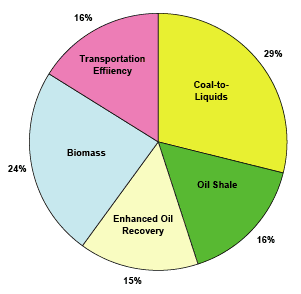Multi-prong approach enhances energy security
 A recently released report from the Southern States Energy Board gives a realistic scenario for increasing "American Energy Security" by eliminating the petroleum import gap. Using a multi-prong approach involving a broad range of technologies, they anticipate that this can be accomplished by 2031. This in spite of the fact that they project liquid fuel demand will increase during that time by 25%.
A recently released report from the Southern States Energy Board gives a realistic scenario for increasing "American Energy Security" by eliminating the petroleum import gap. Using a multi-prong approach involving a broad range of technologies, they anticipate that this can be accomplished by 2031. This in spite of the fact that they project liquid fuel demand will increase during that time by 25%. As can be seen in the accompanying pie chart, the bulk of the technologies are fossil-fuel related - coal-to-liquid conversion, oil shale, and enhanced oil recovery. Like it or not, coal, oil shale, and other domestic fossil fuel feedstocks do represent an alternative to imported oil and natural gas feedstocks. Energy made from these resources are not, however, carbon neutral and they will not simultaneously help to reduce carbon emissions.
As can be seen in the accompanying pie chart, the bulk of the technologies are fossil-fuel related - coal-to-liquid conversion, oil shale, and enhanced oil recovery. Like it or not, coal, oil shale, and other domestic fossil fuel feedstocks do represent an alternative to imported oil and natural gas feedstocks. Energy made from these resources are not, however, carbon neutral and they will not simultaneously help to reduce carbon emissions.
Transportation efficiency means the reduction in demand for oil effected by a gradual changeover from pure gasoline to gasoline blends involving extenders like ethanol and the sale of flex-fuel, hybrid, and plug-in hybrids that use even less gasoline. Biomass includes fuels like ethanol and biodiesel that are made from sugar fermentation, hydrolysis, and gasification.
---------------- American Energy Security Report
American Energy Security Report
A vast array of technologies exist that can produce liquid fuels from coal, oil shale, and biomass resources, that can facilitate enhanced oil recovery from U.S. reservoirs and save millions of barrels per day of liquid fuels in the transportation sector.
Liquid fuels are complex mixtures of hydrocarbons or oxygenated hydrocarbons in the form of ethers or alcohols. The transformation of biomass into these types of compounds involves breaking down the macropolymers of biomass into elemental molecules and then reconfiguring these molecules into the desired fuel compounds.
There are two fundamental approaches to this transformation: one is a bioconversion approach and the other uses thermochemical methods. Commercial ethanol and biodiesel liquid fuels production is well established in the U.S., and new pyrolysis and thermal depolymerization techniques are being developed to produce hydrocarbon fuels from cellulosic resources. Large polygeneration carbon-to-liquids plants can process a varied blend of coal, oil shale, and biomass feedstocks into oil. These combination plants first will gasify the carbon-bearing feedstocks and then combine the product gases into liquid fuels using well established Fisher-Tropsch technology.
technorati BIOblog, BIOconversion, biomass, decentralization, security



No comments:
Post a Comment